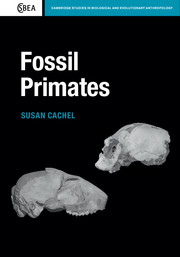Book contents
- Frontmatter
- Dedication
- Contents
- Acknowledgments
- Preface
- 1 Introduction: primates in evolutionary time
- 2 Primate taxonomy
- 3 Fossils and fossilization
- 4 The world of the past
- 5 The lifeways of extinct animals
- 6 Evolutionary processes and the pattern of primate evolution
- 7 Primate origins
- 8 The Paleocene primate radiation
- 9 The Eocene primate radiation
- 10 The Malagasy primate radiation
- 11 The Oligocene bottleneck
- 12 Rise of the anthropoids
- 13 The platyrrhine radiation
- 14 The Miocene hominoid radiation
- 15 The cercopithecoid radiation
- 16 Late Cenozoic climate changes
- 17 Conclusions
- References
- Index
14 - The Miocene hominoid radiation
Published online by Cambridge University Press: 05 April 2015
- Frontmatter
- Dedication
- Contents
- Acknowledgments
- Preface
- 1 Introduction: primates in evolutionary time
- 2 Primate taxonomy
- 3 Fossils and fossilization
- 4 The world of the past
- 5 The lifeways of extinct animals
- 6 Evolutionary processes and the pattern of primate evolution
- 7 Primate origins
- 8 The Paleocene primate radiation
- 9 The Eocene primate radiation
- 10 The Malagasy primate radiation
- 11 The Oligocene bottleneck
- 12 Rise of the anthropoids
- 13 The platyrrhine radiation
- 14 The Miocene hominoid radiation
- 15 The cercopithecoid radiation
- 16 Late Cenozoic climate changes
- 17 Conclusions
- References
- Index
Summary
Introduction
The earliest known hominoid is Rukwapithecus fleaglei, which comes from an Oligocene site in Tanzania dated to 25.2 mya (Stevens et al., 2013). It is known only from the type specimen. The genus Kamoyapithecus is far older (27.8–23.9 mya), but its attribution is uncertain—it is known only from isolated teeth. The first appearance of abundant hominoids is heralded by the genus Proconsul, which appears at 22.5–20 mya. Hominoids thus have a respectably ancient evolutionary history. Midway through this history, they experience an evolutionary radiation. As a set, they are currently teetering on the edge of extinction. Thus, the rise and fall of hominoids has been compressed within the last 15 million years.
The DNA of humans and their closest living relatives, all large-bodied hominoids, has obviously received intense scrutiny. Changes or mutations in mitochondrial and nuclear DNA have been used to construct hominoid phylogenetic trees. However, when hominoids are compared to other primate lineages, the branching length for hominoid lineages is much shorter. This is caused by a decrease in mutation rate per year in the hominoids. Humans, for example, have amassed 30 percent fewer mutations than baboons since their divergence from a last common ancestor (Scally & Durbin, 2012). The decrease in hominoid mutation rate has been termed the “hominoid slowdown,” and it is known to have been caused by an increase in body size itself. Increasing body size increases generation length, and this alone creates a fall in mutation rate, because it lowers the population size of hominoid species. Hence the appearance of relatively large body size in hominoids, beginning in the Early Miocene about 20 mya, has fundamentally reduced the abundance of hominoid species.
- Type
- Chapter
- Information
- Fossil Primates , pp. 214 - 246Publisher: Cambridge University PressPrint publication year: 2015



